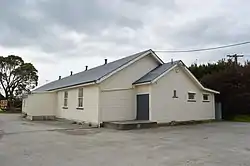Omihi | |
|---|---|
Locality | |
 Omihi Hall | |
| Coordinates: 43°01′S 172°51′E / 43.017°S 172.850°E | |
| Country | New Zealand |
| Region | Canterbury |
| Territorial authority | Hurunui District |
| Ward | East Ward |
| Electorates | |
| Government | |
| • Territorial Authority | Hurunui District Council |
| • Regional council | Environment Canterbury |
| • Mayor of Hurunui | Marie Black |
| • Kaikoura MP | Stuart Smith |
| • Te Tai Tonga MP | Tākuta Ferris |
| Time zone | UTC+12 (New Zealand Standard Time) |
| • Summer (DST) | UTC+13 (New Zealand Daylight Time) |
Omihi or Ōmihi is a rural community in the Hurunui District of the Canterbury Region, on New Zealand's South Island. It is located 21km north-east of Amberley.[1]
Translated from Māori, it means place of (Ō) greeting, wailing or lamentation (mihi).[1]
European settlers began farming the area in the late 19th century.[2]
The Omihi settlement includes a school and a community hall, which is used for a range of functions.[3]
The settlement has a war memorial obelisk, featuring the names of ten local men who died in World War I and five local men who died in World War II.[4]
Demographics
The Omihi statistical area, which also includes Waipara and Greta Valley, covers 717.87 km2 (277.17 sq mi).[5] It had an estimated population of 1,310 as of June 2022,[6] with a population density of 1.8 people per km2.
| Year | Pop. | ±% p.a. |
|---|---|---|
| 2006 | 1,194 | — |
| 2013 | 1,197 | +0.04% |
| 2018 | 1,242 | +0.74% |
| Source: [7] | ||

Omihi had a population of 1,242 at the 2018 New Zealand census, an increase of 45 people (3.8%) since the 2013 census, and an increase of 48 people (4.0%) since the 2006 census. There were 486 households, comprising 660 males and 579 females, giving a sex ratio of 1.14 males per female. The median age was 45.6 years (compared with 37.4 years nationally), with 231 people (18.6%) aged under 15 years, 162 (13.0%) aged 15 to 29, 639 (51.4%) aged 30 to 64, and 207 (16.7%) aged 65 or older.
Ethnicities were 95.2% European/Pākehā, 8.9% Māori, 0.7% Pasifika, 1.0% Asian, and 1.9% other ethnicities. People may identify with more than one ethnicity.
The percentage of people born overseas was 10.6, compared with 27.1% nationally.
Although some people chose not to answer the census's question about religious affiliation, 57.7% had no religion, 32.6% were Christian, 0.2% had Māori religious beliefs, 0.2% were Hindu, 0.2% were Buddhist and 1.0% had other religions.
Of those at least 15 years old, 162 (16.0%) people had a bachelor's or higher degree, and 210 (20.8%) people had no formal qualifications. The median income was $31,000, compared with $31,800 nationally. 141 people (13.9%) earned over $70,000 compared to 17.2% nationally. The employment status of those at least 15 was that 561 (55.5%) people were employed full-time, 189 (18.7%) were part-time, and 18 (1.8%) were unemployed.[7]
Education
Omihi School is a co-educational state primary school for Year 1 to 8 students,[2][8] with a roll of 42 as of April 2023.[9]
The school was founded in 1900 with a roll of 31 and one classroom. The school was expanded between 1906 and 1911, and moved to a new position on the same site in 1948. It currently has two classrooms, an office block, a school house, a library and a swimming pool.[2]
References
- 1 2 "Omihi". nzhistory.govt.nz. Ministry for Culture and Heritage.
- 1 2 3 "Omihi School Official School Website". omihi.school.nz.
- ↑ "Omihi Community Hall". omihihall.co.nz. Omihi Community Hall.
- ↑ Clark, Aaron (2005). "Omihi war memorial". nzhistory.govt.nz. Ministry for Culture and Heritage.
- ↑ "ArcGIS Web Application". statsnz.maps.arcgis.com. Retrieved 27 August 2021.
- ↑ "Population estimate tables - NZ.Stat". Statistics New Zealand. Retrieved 25 October 2022.
- 1 2 "Statistical area 1 dataset for 2018 Census". Statistics New Zealand. March 2020. Omihi (312700). 2018 Census place summary: Omihi
- ↑ "Omihi School Ministry of Education School Profile". educationcounts.govt.nz. Ministry of Education.
- ↑ "Omihi School Education Review Office Report". ero.govt.nz. Education Review Office.